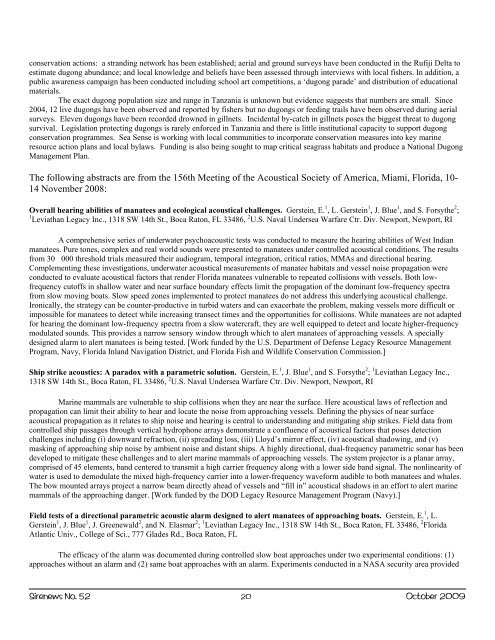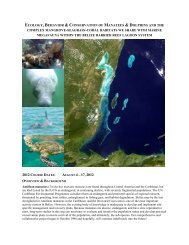Tribute to Dr. Akoi Kouadio - Sirenian International
Tribute to Dr. Akoi Kouadio - Sirenian International
Tribute to Dr. Akoi Kouadio - Sirenian International
You also want an ePaper? Increase the reach of your titles
YUMPU automatically turns print PDFs into web optimized ePapers that Google loves.
conservation actions: a stranding network has been established; aerial and ground surveys have been conducted in the Rufiji Delta <strong>to</strong><br />
estimate dugong abundance; and local knowledge and beliefs have been assessed through interviews with local fishers. In addition, a<br />
public awareness campaign has been conducted including school art competitions, a ‘dugong parade’ and distribution of educational<br />
materials.<br />
The exact dugong population size and range in Tanzania is unknown but evidence suggests that numbers are small. Since<br />
2004, 12 live dugongs have been observed and reported by fishers but no dugongs or feeding trails have been observed during aerial<br />
surveys. Eleven dugongs have been recorded drowned in gillnets. Incidental by-catch in gillnets poses the biggest threat <strong>to</strong> dugong<br />
survival. Legislation protecting dugongs is rarely enforced in Tanzania and there is little institutional capacity <strong>to</strong> support dugong<br />
conservation programmes. Sea Sense is working with local communities <strong>to</strong> incorporate conservation measures in<strong>to</strong> key marine<br />
resource action plans and local bylaws. Funding is also being sought <strong>to</strong> map critical seagrass habitats and produce a National Dugong<br />
Management Plan.<br />
The following abstracts are from the 156th Meeting of the Acoustical Society of America, Miami, Florida, 10-<br />
14 November 2008:<br />
Overall hearing abilities of manatees and ecological acoustical challenges. Gerstein, E. 1 , L. Gerstein 1 , J. Blue 1 , and S. Forsythe 2 ;<br />
1 Leviathan Legacy Inc., 1318 SW 14th St., Boca Ra<strong>to</strong>n, FL 33486, 2 U.S. Naval Undersea Warfare Ctr. Div. Newport, Newport, RI<br />
A comprehensive series of underwater psychoacoustic tests was conducted <strong>to</strong> measure the hearing abilities of West Indian<br />
manatees. Pure <strong>to</strong>nes, complex and real world sounds were presented <strong>to</strong> manatees under controlled acoustical conditions. The results<br />
from 30 000 threshold trials measured their audiogram, temporal integration, critical ratios, MMAs and directional hearing.<br />
Complementing these investigations, underwater acoustical measurements of manatee habitats and vessel noise propagation were<br />
conducted <strong>to</strong> evaluate acoustical fac<strong>to</strong>rs that render Florida manatees vulnerable <strong>to</strong> repeated collisions with vessels. Both lowfrequency<br />
cu<strong>to</strong>ffs in shallow water and near surface boundary effects limit the propagation of the dominant low-frequency spectra<br />
from slow moving boats. Slow speed zones implemented <strong>to</strong> protect manatees do not address this underlying acoustical challenge.<br />
Ironically, the strategy can be counter-productive in turbid waters and can exacerbate the problem, making vessels more difficult or<br />
impossible for manatees <strong>to</strong> detect while increasing transect times and the opportunities for collisions. While manatees are not adapted<br />
for hearing the dominant low-frequency spectra from a slow watercraft, they are well equipped <strong>to</strong> detect and locate higher-frequency<br />
modulated sounds. This provides a narrow sensory window through which <strong>to</strong> alert manatees of approaching vessels. A specially<br />
designed alarm <strong>to</strong> alert manatees is being tested. [Work funded by the U.S. Department of Defense Legacy Resource Management<br />
Program, Navy, Florida Inland Navigation District, and Florida Fish and Wildlife Conservation Commission.]<br />
Ship strike acoustics: A paradox with a parametric solution. Gerstein, E. 1 , J. Blue 1 , and S. Forsythe 2 ; 1 Leviathan Legacy Inc.,<br />
1318 SW 14th St., Boca Ra<strong>to</strong>n, FL 33486, 2 U.S. Naval Undersea Warfare Ctr. Div. Newport, Newport, RI<br />
Marine mammals are vulnerable <strong>to</strong> ship collisions when they are near the surface. Here acoustical laws of reflection and<br />
propagation can limit their ability <strong>to</strong> hear and locate the noise from approaching vessels. Defining the physics of near surface<br />
acoustical propagation as it relates <strong>to</strong> ship noise and hearing is central <strong>to</strong> understanding and mitigating ship strikes. Field data from<br />
controlled ship passages through vertical hydrophone arrays demonstrate a confluence of acoustical fac<strong>to</strong>rs that poses detection<br />
challenges including (i) downward refraction, (ii) spreading loss, (iii) Lloyd’s mirror effect, (iv) acoustical shadowing, and (v)<br />
masking of approaching ship noise by ambient noise and distant ships. A highly directional, dual-frequency parametric sonar has been<br />
developed <strong>to</strong> mitigate these challenges and <strong>to</strong> alert marine mammals of approaching vessels. The system projec<strong>to</strong>r is a planar array,<br />
comprised of 45 elements, band centered <strong>to</strong> transmit a high carrier frequency along with a lower side band signal. The nonlinearity of<br />
water is used <strong>to</strong> demodulate the mixed high-frequency carrier in<strong>to</strong> a lower-frequency waveform audible <strong>to</strong> both manatees and whales.<br />
The bow mounted arrays project a narrow beam directly ahead of vessels and “fill in” acoustical shadows in an effort <strong>to</strong> alert marine<br />
mammals of the approaching danger. [Work funded by the DOD Legacy Resource Management Program (Navy).]<br />
Field tests of a directional parametric acoustic alarm designed <strong>to</strong> alert manatees of approaching boats. Gerstein, E. 1 , L.<br />
Gerstein 1 , J. Blue 1 , J. Greenewald 2 , and N. Elasmar 2 ; 1 Leviathan Legacy Inc., 1318 SW 14th St., Boca Ra<strong>to</strong>n, FL 33486, 2 Florida<br />
Atlantic Univ., College of Sci., 777 Glades Rd., Boca Ra<strong>to</strong>n, FL<br />
The efficacy of the alarm was documented during controlled slow boat approaches under two experimental conditions: (1)<br />
approaches without an alarm and (2) same boat approaches with an alarm. Experiments conducted in a NASA security area provided<br />
Sirenews No. 52 20 Oc<strong>to</strong>ber 2009













